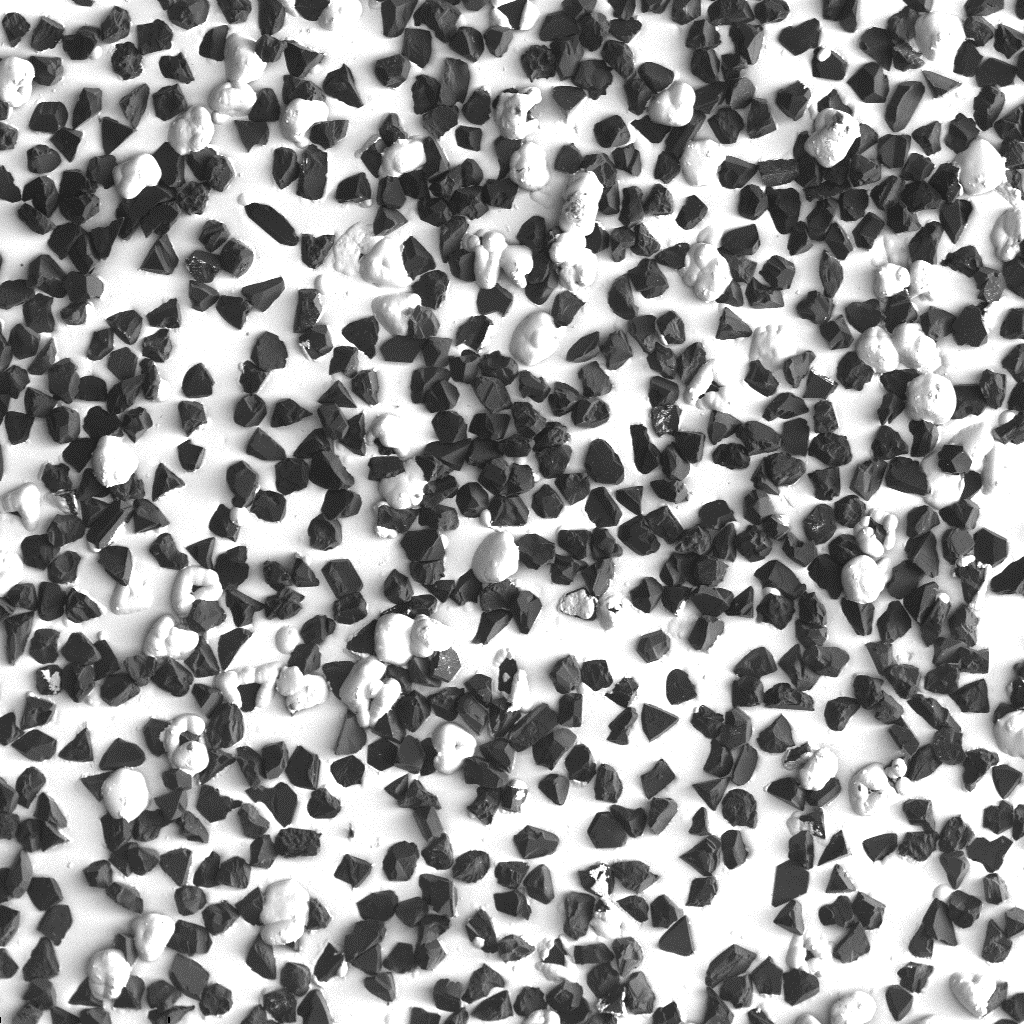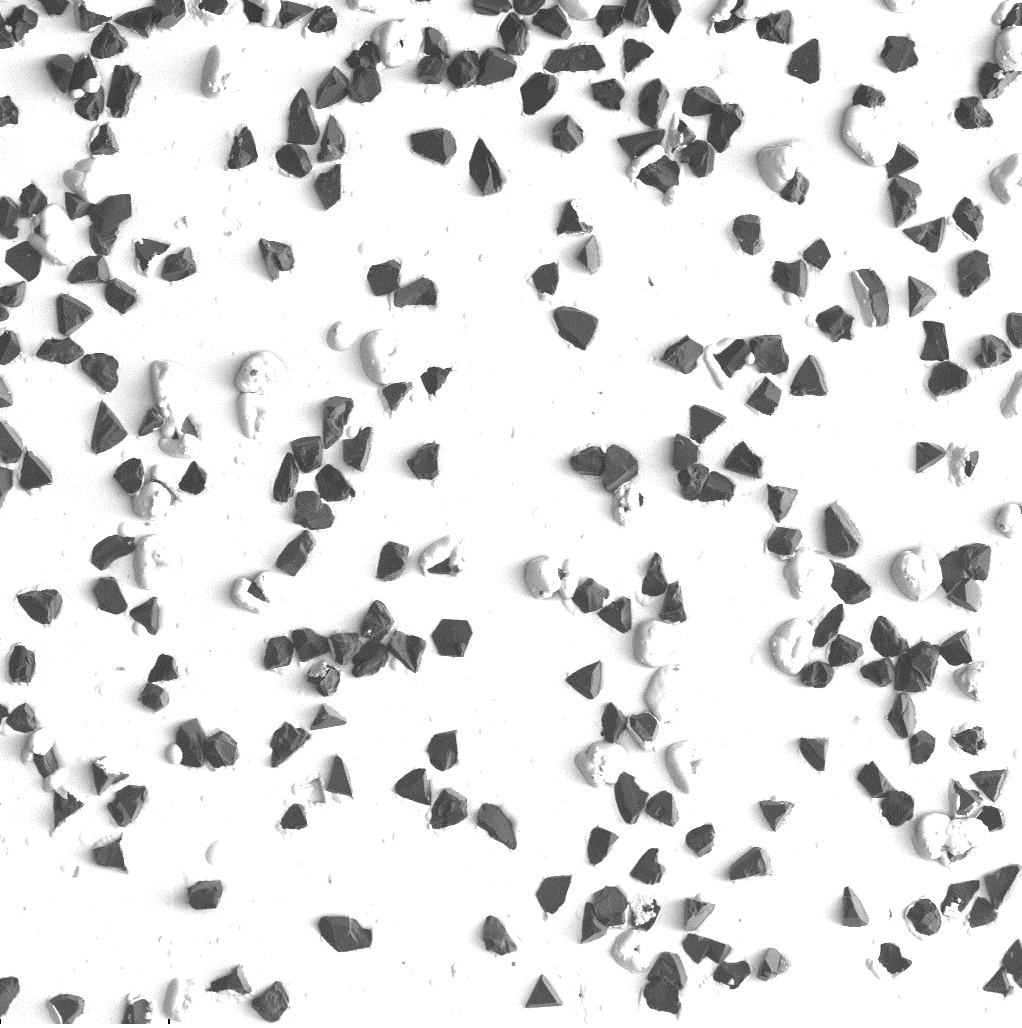Touching particle accurate counting
|
Hi,
I am desperately trying to find an automatic way to count diamonds (approx 100 um size) on a metallic substrate on SEM imaging. The problem is that they are sometimes overlapping, making them hard to separate, even by using the watersheding tool. (you'll see very big parts not affected by this tool) The method I use is not very accurate: - gaussian blur or substrack background (sometimes it works better) - tresholding - watersheding - analyse particle (area 200-infinite, circularity 0.35-1.00) There are around 620 diamonds in the dense onem and 240 in the less dense one. I can only manage to reach a 10% accuracy in the counting, but I would like to reach 1%. Does anybody knows a better way to do this, or knows a good plugin for this kind of work? A good thing would be to be able to force the watersheding above a given area, so that I don't have big agglomerates, but I don't know if this already exists... Thanks,  
|
Re: Touching particle accurate counting
|
Hi Al Menia,
maybe you can improve the situation by avoiding the shadows, i.e., by measuring backscattered electrons instead of secondary electrons? Nevertheless, the 'dense' example will be difficult. Also the white particles are a problem, they hide some of the diamonds. By the way, your sample images have only 4 bits resolution (16 gray levels), maybe due to conversion to an RGB .png file. This makes processing more difficult than necessary. Maybe your SEM has some output format that retains the full image data, or there is some plugin (BioFormats?) that can read the native data format of the SEM. Michael ________________________________________________________________ On Jan 14, 2015, at 18:02, Al Menia wrote: > Hi, > > I am desperately trying to find an automatic way to count diamonds (approx > 100 um size) on a metallic substrate on SEM imaging. The problem is that > they are sometimes overlapping, making them hard to separate, even by using > the watersheding tool. (you'll see very big parts not affected by this tool) > The method I use is not very accurate: > - gaussian blur or substrack background (sometimes it works better) > - tresholding > - watersheding > - analyse particle (area 200-infinite, circularity 0.35-1.00) > > There are around 620 diamonds in the dense onem and 240 in the less dense > one. I can only manage to reach a 10% accuracy in the counting, but I would > like to reach 1%. > > Does anybody knows a better way to do this, or knows a good plugin for this > kind of work? > A good thing would be to be able to force the watersheding above a given > area, so that I don't have big agglomerates, but I don't know if this > already exists... > > Thanks, > > > <http://imagej.1557.x6.nabble.com/file/n5011214/dense.png> > <http://imagej.1557.x6.nabble.com/file/n5011214/low_density.png> -- ImageJ mailing list: http://imagej.nih.gov/ij/list.html |
|
In reply to this post by Al Menia
Hi Al,
> The problem is that they are sometimes overlapping, making > them hard to separate, even by using the watersheding tool. The "Find Maxima" command is sometimes useful in situations like these. Here is a workflow which counts 643 diamonds on your dense image: run("8-bit"); run("Invert"); run("Subtract Background...", "rolling=50"); run("Gaussian Blur...", "sigma=2"); run("Find Maxima...", "noise=10 output=[Point Selection] exclude"); run("Measure"); Not perfect, but not terrible. You could also try the Trainable Weka Segmentation plugin [1] and see how that treats you. Regards, Curtis [1] http://fiji.sc/Trainable_Weka_Segmentation On Wed, Jan 14, 2015 at 11:02 AM, Al Menia <[hidden email]> wrote: > Hi, > > I am desperately trying to find an automatic way to count diamonds (approx > 100 um size) on a metallic substrate on SEM imaging. The problem is that > they are sometimes overlapping, making them hard to separate, even by using > the watersheding tool. (you'll see very big parts not affected by this > tool) > The method I use is not very accurate: > - gaussian blur or substrack background (sometimes it works better) > - tresholding > - watersheding > - analyse particle (area 200-infinite, circularity 0.35-1.00) > > There are around 620 diamonds in the dense onem and 240 in the less dense > one. I can only manage to reach a 10% accuracy in the counting, but I would > like to reach 1%. > > Does anybody knows a better way to do this, or knows a good plugin for this > kind of work? > A good thing would be to be able to force the watersheding above a given > area, so that I don't have big agglomerates, but I don't know if this > already exists... > > Thanks, > > > <http://imagej.1557.x6.nabble.com/file/n5011214/dense.png> > <http://imagej.1557.x6.nabble.com/file/n5011214/low_density.png> > > > > -- > View this message in context: > http://imagej.1557.x6.nabble.com/Touching-particle-accurate-counting-tp5011214.html > Sent from the ImageJ mailing list archive at Nabble.com. > > -- > ImageJ mailing list: http://imagej.nih.gov/ij/list.html > -- ImageJ mailing list: http://imagej.nih.gov/ij/list.html |
|
In reply to this post by Michael Schmid
Hey! Thanks for answering.
This is a backscattered image, but this SEM seems to add a little SE detection, which indeed add shadows in the image (I will use another SEM or change some parameters next time). I normally have .tif images but it seems that this website does not accept them, so I had to convert them in .png. Here is are two other .jpg images with no shadows (and no white particles as you called them), I still have a lot of difficulties to process them properly... Having a global idea of the number of diamonds is all right, but if i want to have 1% accuracy or so it's another problem. I added the processed images to illustrate the problem: some particles are split with watersheding and become too small, whereas some others are not cut and are too big. Is there a way to fix that? Image 1 image 1 processed image 2 image 2 processed What really annoys me is that the human eye perfectly count the diamonds, but that it becomes incredibly more difficult to do it with a computer :( |
Re: Touching particle accurate counting
|
Is it possible to do some sort of geometric averaging and estimate the
count? For example, if you measure a composite particle that has 3 times the average area (which you'd set I presume), then it bins this as 3 particles. Or do you need the exact measurements of every single particle? On Wed, Jan 14, 2015 at 2:46 PM, Al Menia <[hidden email]> wrote: > Hey! Thanks for answering. > > This is a backscattered image, but this SEM seems to add a little SE > detection, which indeed add shadows in the image (I will use another SEM or > change some parameters next time). I normally have .tif images but it seems > that this website does not accept them, so I had to convert them in .png. > > Here is are two other .jpg images with no shadows (and no white particles > as > you called them), I still have a lot of difficulties to process them > properly... Having a global idea of the number of diamonds is all right, > but > if i want to have 1% accuracy or so it's another problem. > > I added the processed images to illustrate the problem: some particles are > split with watersheding and become too small, whereas some others are not > cut and are too big. Is there a way to fix that? > Image 1 <http://i.imgur.com/IkOeq0C.jpg> > image 1 processed <http://i.imgur.com/2MEaKvm.jpg> > image 2 <http://i.imgur.com/HQFwcL0.jpg> > image 2 processed <http://i.imgur.com/KHcwR3O.jpg> > > What really annoys me is that the human eye perfectly count the diamonds, > but that it becomes incredibly more difficult to do it with a computer :( > > > > > > -- > View this message in context: > http://imagej.1557.x6.nabble.com/Touching-particle-accurate-counting-tp5011214p5011218.html > Sent from the ImageJ mailing list archive at Nabble.com. > > -- > ImageJ mailing list: http://imagej.nih.gov/ij/list.html > -- ImageJ mailing list: http://imagej.nih.gov/ij/list.html |
|
The first info I need is the total number of grains, but if I can also have measurements for each particle that's even better..
The problem with using the averaging is that some grains can come out more or less of the metallic matrix, and that can really affect the observed area. Moreover, some shape-sorted grains can also have quite different visible area, depending on what side you are observing... |
«
Return to ImageJ
|
1 view|%1 views
| Free forum by Nabble | Edit this page |

